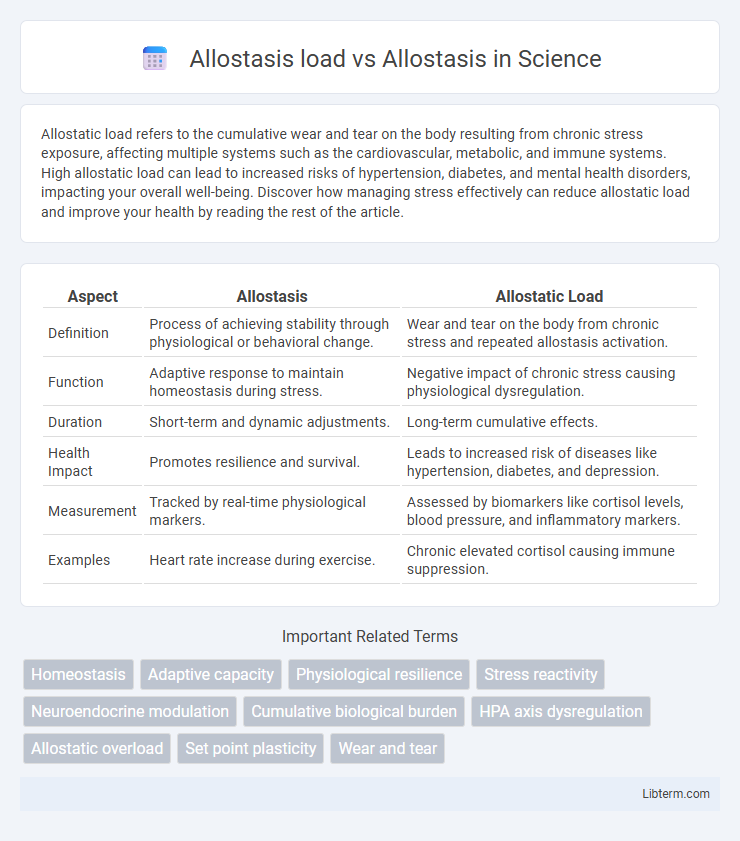Allostatic load refers to the cumulative wear and tear on the body resulting from chronic stress exposure, affecting multiple systems such as the cardiovascular, metabolic, and immune systems. High allostatic load can lead to increased risks of hypertension, diabetes, and mental health disorders, impacting your overall well-being. Discover how managing stress effectively can reduce allostatic load and improve your health by reading the rest of the article.
Table of Comparison
| Aspect | Allostasis | Allostatic Load |
|---|---|---|
| Definition | Process of achieving stability through physiological or behavioral change. | Wear and tear on the body from chronic stress and repeated allostasis activation. |
| Function | Adaptive response to maintain homeostasis during stress. | Negative impact of chronic stress causing physiological dysregulation. |
| Duration | Short-term and dynamic adjustments. | Long-term cumulative effects. |
| Health Impact | Promotes resilience and survival. | Leads to increased risk of diseases like hypertension, diabetes, and depression. |
| Measurement | Tracked by real-time physiological markers. | Assessed by biomarkers like cortisol levels, blood pressure, and inflammatory markers. |
| Examples | Heart rate increase during exercise. | Chronic elevated cortisol causing immune suppression. |
Introduction to Allostasis
Allostasis refers to the process by which the body achieves stability through physiological or behavioral change in response to stress or environmental demands. Unlike homeostasis, which maintains internal equilibrium, allostasis actively regulates multiple systems to adapt to challenges. Understanding allostasis is essential for recognizing how chronic stress can lead to allostatic load, the cumulative wear and tear on the body.
Defining Allostatic Load
Allostatic load refers to the cumulative physiological wear and tear on the body's systems due to chronic stress and repeated activation of allostasis, the process by which the body achieves stability through change. It quantifies the long-term effects of stress-induced dysregulation in neuroendocrine, immune, and cardiovascular functions. Measuring allostatic load involves integrated biomarkers such as cortisol levels, blood pressure, and inflammatory markers to assess the impact of prolonged stress exposure on health outcomes.
Key Differences: Allostasis vs Allostatic Load
Allostasis refers to the process by which the body achieves stability through physiological or behavioral change in response to stressors, maintaining homeostasis. Allostatic load, however, represents the cumulative wear and tear on the body's systems due to chronic overactivation or inefficient regulation of allostasis. The key difference lies in allostasis being the adaptive process, while allostatic load denotes the negative health impact resulting from prolonged or repeated stress responses.
Mechanisms Underlying Allostasis
Allostasis refers to the process by which the body achieves stability through physiological or behavioral change, employing mechanisms such as hormonal regulation, autonomic nervous system adjustments, and immune responses to meet environmental demands. Allostatic load represents the cumulative wear and tear on the body's systems resulting from chronic activation of allostatic mechanisms, leading to impaired regulation and increased disease risk. Key mechanisms underlying allostasis include the hypothalamic-pituitary-adrenal (HPA) axis activation, sympathetic nervous system engagement, and inflammatory cytokine modulation, which collectively maintain homeostasis but contribute to allostatic load when persistently overactivated.
Biological Impact of Allostatic Load
Allostasis refers to the process by which the body achieves stability through physiological or behavioral change in response to stress. Allostatic load represents the cumulative biological burden imposed by chronic stress, resulting in wear and tear on bodily systems such as the cardiovascular, metabolic, and immune systems. High allostatic load is associated with increased risks of hypertension, insulin resistance, and impaired immune function, contributing to the development of chronic diseases.
Stress Response: Adaptive vs Maladaptive
Allostasis refers to the body's process of achieving stability through physiological or behavioral change in response to stress, promoting adaptive stress responses that restore balance. Allostatic load accumulates when chronic or repeated stress overwhelms these adaptive mechanisms, leading to maladaptive responses that impair health and increase risk for diseases such as hypertension and depression. Understanding the distinction between adaptive allostasis and maladaptive allostatic load is crucial for developing interventions that mitigate the harmful effects of prolonged stress exposure.
Chronic Stress and Health Outcomes
Allostasis load refers to the cumulative physiological wear and tear on the body resulting from chronic activation of allostasis, the process by which the body maintains stability through change in response to stress. Prolonged exposure to chronic stress leads to increased allostatic load, disrupting hormonal, cardiovascular, and immune systems, which contributes to adverse health outcomes such as hypertension, diabetes, and mental health disorders. Measuring allostatic load through biomarkers like cortisol levels and inflammatory markers provides insight into the long-term impact of stress on overall health.
Measuring Allostasis and Allostatic Load
Measuring allostasis involves assessing the body's adaptive physiological responses to stress through biomarkers such as cortisol, heart rate variability, and inflammatory markers. Allostatic load quantifies the cumulative wear and tear on the body resulting from chronic stress exposure, often measured using composite indices that combine metabolic, cardiovascular, and neuroendocrine parameters. Biomarkers like blood pressure, waist-to-hip ratio, and glycosylated hemoglobin are crucial in evaluating allostatic load to predict the risk of stress-related diseases.
Reducing Allostatic Load: Strategies and Interventions
Reducing allostatic load involves managing chronic stress through strategies such as mindfulness meditation, regular physical activity, and healthy sleep patterns, which help regulate the body's stress response system. Interventions targeting social support, cognitive-behavioral therapy (CBT), and balanced nutrition also play critical roles in minimizing the cumulative physiological wear and tear associated with allostasis. Effective reduction of allostatic load promotes improved cardiovascular, metabolic, and immune function, thereby enhancing overall resilience and long-term health outcomes.
Summary: Importance of Allostasis in Health
Allostasis refers to the body's process of achieving stability through physiological change, enabling adaptation to stressors and maintaining overall health. Allostatic load represents the cumulative wear and tear on the body from chronic stress and repeated allostatic responses, potentially leading to health issues such as cardiovascular disease and metabolic disorders. Understanding allostasis highlights the importance of adaptive stress responses in promoting resilience and preventing disease, while managing allostatic load is crucial for preserving long-term health.
Allostasis load Infographic

 libterm.com
libterm.com